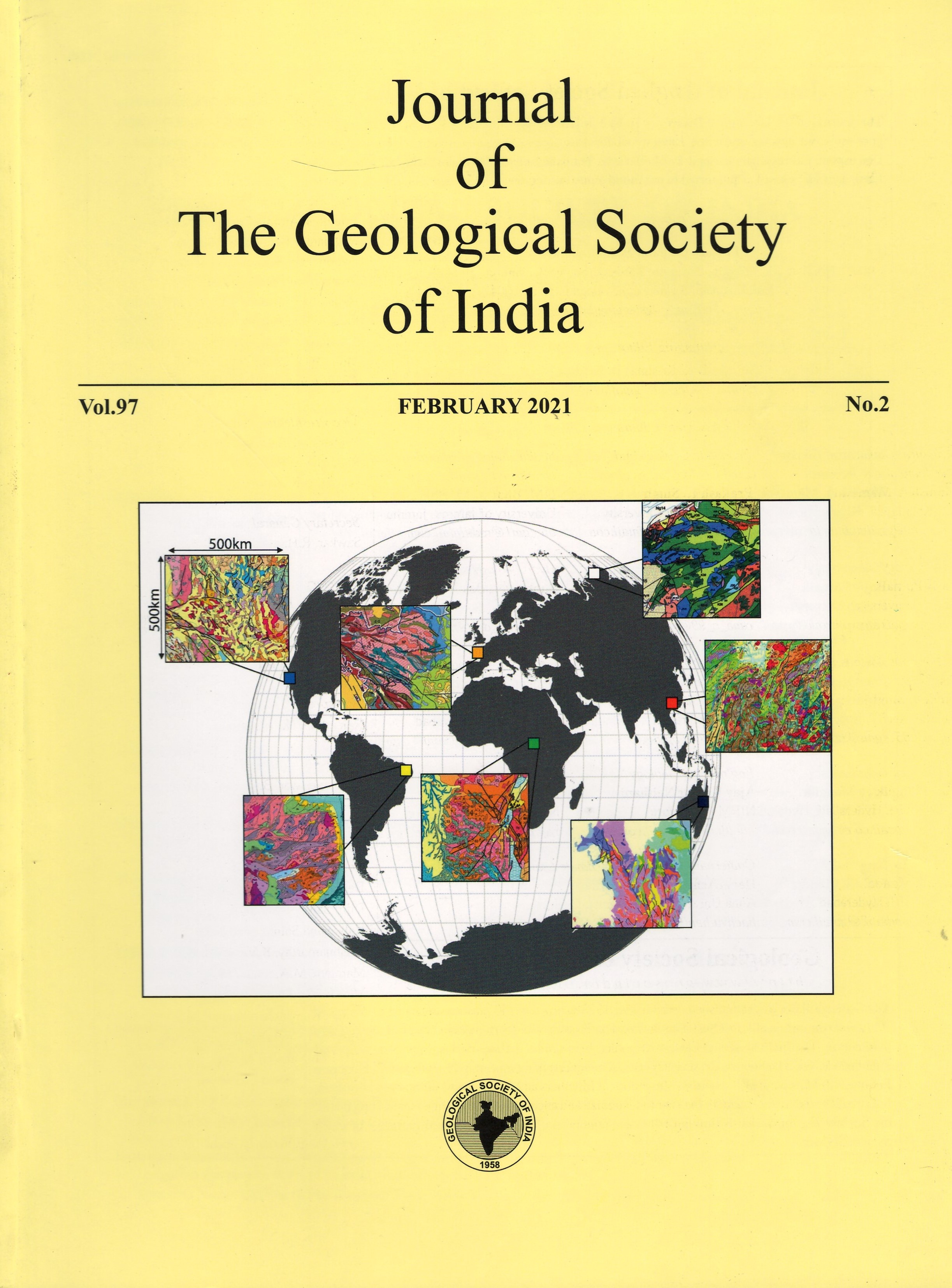Sulphur Isotopic Studies of Pyrite from Gogi Uranium Deposit, Bhima Basin, Karnataka
DOI:
https://doi.org/10.1007/s12594-021-1643-0Keywords:
No Keywords.Abstract
Uranium deposit at Gogi area is located along the E-W Gundahalli-Gogi-Kurlegere (GK) fault, in the brecciated impure limestone of Shahabad Formation of the Bhima Group of sediments and the basement granite in the central part of the Meso-Neoproterozoic Bhima basin. Uranium mineralisation is associated mainly with sulphide bearing minerals and secondary calcite. Ore microscopic studies indicate that among the sulphide minerals pyrite is predominant (about 98%) with subordinate amounts of chalcopyrite, chalcocite, marcasite, arsenopyrite and galena. Megascopically, three different varieties of pyrite viz., euhedral, lumpy and vein types are identified in the limestone and siltstone. Ore microscopic studies reveal that vein type pyrite and lumpy pyrite are fractured and crushed. Euhedral pyrite is idiomorphic and devoid of any fractures. The pyrite samples were analysed for δ 34S sulphur isotopes. The δ 34S values show a wide range from -30.51 to +20.77‰ (Canyon Diablo Troilite, CDT). δ 34S values of pyrite can be classified into three groups depending on the values. High values of +17.73 to +20.77 ‰ (CDT) of euhedral pyrite (Py-I) indicate sedimentary pyrite formed due to bacterial reduction of sea water sulphate in relatively closed system, while pyrite (Py-II) having negative values of δ 34S imply bacterial reduction of sea water sulphate in open system. The third group (Py-III) of pyrite have δ 34S values of -0.51‰ (CDT) and 7.38‰(CDT), indicating their magmatic/hydrothermal origin. Sulphides in the deformed sediments acted as reducing agent for uranium precipitation.
Downloads
Metrics
Issue
Section
Downloads
Published
How to Cite
References
Asha, K. and Basu, H. (2019) Stable Isotope Report No. Report no SIL-02/2018-19, Atomic Minerals Directorate for Exploration and Research, Hyderabad, Unpublished, pp.1-7.
Canfield, D.E. and Teske, A. (1996) Late Proterozoic rise in atmospheric oxygen concentration inferred from phylogenetic and sulphur-isotope studies. Nature, v.382, pp.127–132.
Canfield, D.E. (1998) A new model for Proterozoic ocean chemistry. Nature, v.396, pp.450–453.
Canfield, D.E. (2004) The evolution of the earth-surface sulphur reservoir. Amer. Jour. Sci., v.304, pp.839–61.
Chaki, A., Panneerselvam, A. and Chavan, S.J. (2005) Uranium exploration in the upper Proterozoic Bhima Basin, Karnataka, India: A new target area. In: Uranium production and raw materials for the nuclear fuel cycle – supply and demand, economics, the environment and energy security. Proceedings of an international symposium, Vienna, 20-24 June 2005. IAEA-CN-128, pp.183-194.
Dhana Raju, R., Mary K. Kumar, Babu, E.V.S.S.K. and Pandit, S.A. (2002) Uranium mineralization in the Neoproterozoic Bhima Basin at Gogi and near Ukinal- Ore petrology and mineral chemistry. Jour. Geol. Soc. India, v.59, pp.299-321.
Faure, G. (1986) Principles of Isotope Geology,2nd edition, John Wiley & Sons, NewYork, 547p.
Fike David, A., Bradley, A.S. and Rose, C.V. (2015) Rethinking the Ancient Sulfur Cycle, Annual Review. Earth Planet. Sci., v. 43, pp.593-622.
Gellatly, A.M. and Lyons, T.W. (2005) Trace sulfate in mid proterozoic carbonates and the sulfur isotope record biospheric evolution. Geochim. Cosmochim. Acta, v.69(15), pp.3813–3829.
Johnston, D.T., Farquhar J, Summons R.E., Shen Y., Kaufman A.J., Masterson A.L. and Canfield, D.E. (2008) Sulfur isotope biogeochemistry of the Proterozoic McArthur Basin. Geochimica. Cosmochim. Acta, v.72, pp.4278–4290.
Kah, L.C., Lyons, T.W. and Frank, T.D. (2004) Low marine sulphate and protracted oxygenation of the proterozoic biosphere. Nature, v.431(7010), pp.834–838.
Kale, V.S. and Peshwa, V.V. (1995) Bhima Basin. Geological Society of India, Bangalore, 142p.
Lyons, T.W., Luepke, J.J., Schreiber, M.E. and Zieg, G.A. (2000) Sulfur geochemical constraints on Mesoproterozoic restricted marine deposition: lower Belt Supergroup, northwestern United States. Geochim. Cosmochim. Acta, v.64, pp.427–437.
Lyons, T.W., Gellatly, A.M., Goldrick, P.J. and Kah, L.C. (2006) Proterozoic sedimentary exhalative (SEDEX) deposits and links to evolving global ocean chemistry. Geol. Soc. Amer. Mem., no.198, pp.169–184.
Nagarajan, R., Alcides N. Sial, Armstrong-Altrin J.S., Madhavaraju J. and Nagendra R. (2008) Carbon and oxygen isotope geochemistry of Neoproterozoic limestones of the Shahabad Formation, Bhima basin, Karnataka, southern India. Revista Mexicana de Ciencias Geologicas, v.25(2), pp.225-235.
Pandey, U.K., Asha K.,Bhattacharya D., Roy D., Sharma A.K., Banerjee R., Bhatt A.K. and Verma M.B. (2019) ‘C’ and ‘O’ isotope studies on micritic limestone from Shahabad formation: evidence of inorganic marine carbonate deposition in Bhima Basin, Karnataka, India and its implication on uranium exploration. Jour. Appld. Geochemistry, v.21(1), pp.65-73.
Pandit, S.A., Natarajan, V., Patnaik, J.K. (1995) Annual Report of field season 1994-95. Atomic Minerals Directorate for Exploration and Research, Southern Region, Unpublished.
Pandit, S.A., Natarajan, V. and Dhanaraju, R. (2002) Exploration for Uranium in the Bhima Basin in parts of Karnataka, India. Exploration and Research for Atomic Minerals, v.14, pp.59-78.
Patnaik, S., Hegde, G.N., Panneerselvam, A., Jain, A.K., Verma, M.B. and Rai, A.K.(2011) Textural characterization of pyrite from Gogi Uranium deposit, Bhima Basin, Gulbarga district, Karnataka: Implications for ore genesis. Indian Mineralogist, v.45(1), pp.121-129.
Poulton, S.W., Fralick P.W. and Canfield D.E. (2004) The transition to a sulphidic ocean 1.84 billion years ago. Nature, v.431(7005), pp.173–177.
Radhakrishna, B.P. and Vaidhyanadhan, R. (1994) Geology of Karnataka, Geological Society of India, Bangalore, 298p.
Sarkar, A., Chakraborty, P.P., Mishra, B., Bera, M.K., Sanyal, P. and Paul, S. (2010) Mesoproterozoic sulphidic ocean, delayed oxygenation and evolution of early life: sulphur isotope clues from Indian Proterozoic basins. Geol. Magz., v.147(2), pp.206-218.
Shen Y., Canfield D. E. and Knoll A. H. (2002) Middle Proterozoic ocean chemistry: evidence from the McArthur Basin, northern Australia. Amer. Jour. Sci., v.302(2), pp.81–109.
Shen, Y., Knoll, A.H. and Walter, M.R. (2003) Evidence for low sulphate and anoxia in a mid-Proterozoic marine basin. Nature, v.423(6940), pp.632–635.
Strauss, H. and Schieber, J. (1990) A sulfur isotope study of pyrite genesis: The Mid-Proterozoic Newland Formation, Belt Supergroup, Montana. Geochim. Cosmochim. Acta, v.54, pp.197–204.
Thode, H.G.(1970) Sulfur Isotope Geochemistry and fractionation between coexisting sulphide minerals. Mineral Soc. Amer. Spec. Paper 3, pp.133-144.
Yutong Yan , Na Zhang, Shengrong Li and Yongsheng Li (2014) Mineral chemistry and isotope geochemistry of pyrite from the Heilangou gold deposit, Jiaodong Peninsula, Eastern China. Geoscience Frontiers, v.5, pp.205-213.

 Sikta Patnaik
Sikta Patnaik






